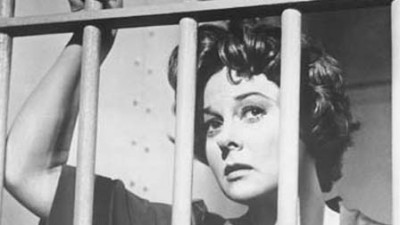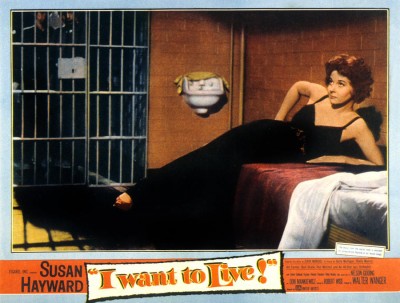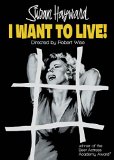| Reviews & Columns |
|
Reviews DVD TV on DVD Blu-ray 4K UHD International DVDs In Theaters Reviews by Studio Video Games Features Collector Series DVDs Easter Egg Database Interviews DVD Talk Radio Feature Articles Columns Anime Talk DVD Savant Horror DVDs The M.O.D. Squad Art House HD Talk Silent DVD
|
DVD Talk Forum |
|
|
| Resources |
|
DVD Price Search Customer Service #'s RCE Info Links |
|
Columns
|
|
|
I Want to Live!
 Robert Wise's 1958 film I Want to Live!, beautifully restored by Kino Lorber for its recent DVD release, tells the supposedly true story of Barbara Graham (an emotionally incendiary Susan Hayward), a prostitute who may have been wrongfully convicted of the murder of an elderly woman in Los Angeles. The film is less notable for the veracity surrounding the facts of Barbara's life and trial than it is for the way it uses noir style to reach a heightened version of the truth. There is an emotional truth that the film achieves through its dreamy style and its critique of the world that Barbara occupies, and that ultimately judges her.
Robert Wise's 1958 film I Want to Live!, beautifully restored by Kino Lorber for its recent DVD release, tells the supposedly true story of Barbara Graham (an emotionally incendiary Susan Hayward), a prostitute who may have been wrongfully convicted of the murder of an elderly woman in Los Angeles. The film is less notable for the veracity surrounding the facts of Barbara's life and trial than it is for the way it uses noir style to reach a heightened version of the truth. There is an emotional truth that the film achieves through its dreamy style and its critique of the world that Barbara occupies, and that ultimately judges her.Barbara dwells in a seedy underworld occupied by druggies, fellow prostitutes, jazz musicians, and dark nightclubs. She drifts through this world, searching for stability and family, left on the margins of the criminal underworld. The film rounds out its critique of the false notion of the nuclear family in several key scenes. In the first scene, Barbara takes the fall for a prostitution charge to protect a john when she realizes he has a wife and children back home. Barbara's decision to protect him underlines her sentimental notions of family, which, later, prove unattainable for her. The film also explores notions of family during a scene near the second act, when a prison official notes that Barbara and her mother were institutionalized in the same prison. Barbara also fulity seeks stability through her marriage with an abusive drug addict, from whom she flees, forcing her back into the seedy criminal underworld. In 1950s America, family and stability simply don't exist for a woman like Barbara. Hayward's sympathetic portrayal of Graham condemns false notions of conventional family life. The film is about her inability to conform to social norms as much as it's about her trial for murder, and the judgement that society heaps upon her.
Barbara then meets Emmit Perkins (Philip Coolidge), John Santos (Lou Krugman), and Bruce King (James Philbrook), three men, who, unbeknownst to her, have murdered an elderly woman for 500,000 dollars. When Barbara is swept back into the seedy criminal underworld after her failed attempt at stability through family life, she is accused of murdering the elderly woman, and is given the death penalty after Perkins, King and Santos get off with easier sentences.
 Barbara's murder trial in I Want to Live! is told largely through the news headlines that condemn her, and through the straight-laced society that sentences her mostly for her amoral lifestyle. Director Wise creates sympathy for Barbara through the film's critique of the non-criminal world that judges people like her for living outside of the mores of mainstream society. Her accusers, the media, the legal system, and the public are an unforgiving entity that has presumed her guilt based on her status as a prostitute. The film clearly underlines its position that Barbara is innocent of murder, but, far more importantly, it also condemns society for judging her.
Barbara's murder trial in I Want to Live! is told largely through the news headlines that condemn her, and through the straight-laced society that sentences her mostly for her amoral lifestyle. Director Wise creates sympathy for Barbara through the film's critique of the non-criminal world that judges people like her for living outside of the mores of mainstream society. Her accusers, the media, the legal system, and the public are an unforgiving entity that has presumed her guilt based on her status as a prostitute. The film clearly underlines its position that Barbara is innocent of murder, but, far more importantly, it also condemns society for judging her.
I Want to Live!'s visual style heightens the film's plea for Barbara's innocence and reaches a level of truthfulness that cannot be achieved by merely recounting surface-level facts. The film's balance between its black and white scenes, the outlining of criminal archetypes, the pulsating jazz score, the canted camera angles, render a sympathetic portrait of Barbara that is abstracted through I Want to Lives!'s visual swirl of noir archetypes. Her world pulsates with life. Contrarily, the prison scenes, in which we view the process of her death in the gas chamber in a coldly matter-of-fact way, give the system that condemns her, and its sense of justice, an unforgiving, sharp style that visualizes its view of Barbara and people like her.
I Want to Live! pleads for Barbara and people like her. The film casts members of the criminal underworld simply as people who are just trying to survive, like the rest of us. Our contemporary society, especially our comparatively uncensored movies and TV shows, have desensitized us to violence and murder, and to the idea that the death penalty and the killing of others in general are normal, acceptable ways of carrying out justice. As viewers of film and TV, we don't flinch much anymore at violence. Consequently, we don't question very often whether or not ending lives out of some vague duty to legal codes is morally right. I Want to Live!, with its lack of blood-letting, or any representation of the murder at the center of the film, shows the impact of killing in a way that conveys the human toll of sending others to their deaths in a manner that bloodier, ostensibly more realistic modern depictions of violence and revenge cannot.
In our current, dangerous climate, where film/TV/news killings have desensitized us to the point where our spectatorship has detached us from the impact of violence, we need movies like I Want to Live! to show us how grisly and barbaric a society can become towards itself.
The DVD:
Video: Kino Lorber has remastered I Want to Live!, and in doing so, has brought out the crispness of its black and white images. The film is presented in its original Anamorphic widescreen format. Light and shadows are among the best I've scene in any noir-styled film and appear perfectly balanced. In particular, notice the way cigarette smoke and rim lighting are used in many scenes to outline figures. The uses of smoke, shadow, and halo lighting are nearly as perfect as some of the best films noir, including the cinematography in Carol Reed's The Third Man.
Audio: The Dolby soundtrack is especially well-suited for the film's Jazz score, which lends quite well to its dizzying visual style in some scenes, especially the film's Jazz club opening.
Extras: There are no substantial extras, but there is an original theatrical trailer for the film.
Final Thoughts:
A cursory search about the real-life murder trial that inspired I Want to Live! would lead one to believe that Barbara Graham probably did commit the murder she was accused of. But this makes the film all the more extraordinary. Wise's visuals and Hayward's extraordinary pathos lend the film an emotional, ecstatic truth that goes beyond mere fact to offer a portrait of sympathy towards down-and-out people like Graham while condemning the society that sends her to her death. Compared to modern films that have numbed us to the real-life effects of violence, I Want to Lives! turns the facts of Graham's life and trial into a work that makes a convincing argument against the death penalty while pleading for the humanity of societal cast-offs.
|
| Popular Reviews |
| Sponsored Links |
|
|
| Sponsored Links |
|
|
| Release List | Reviews | Shop | Newsletter | Forum | DVD Giveaways | Blu-Ray | Advertise |
|
Copyright 2024 DVDTalk.com All Rights Reserved. Legal Info, Privacy Policy, Terms of Use,
Manage Preferences,
Your Privacy Choices | |||||||












